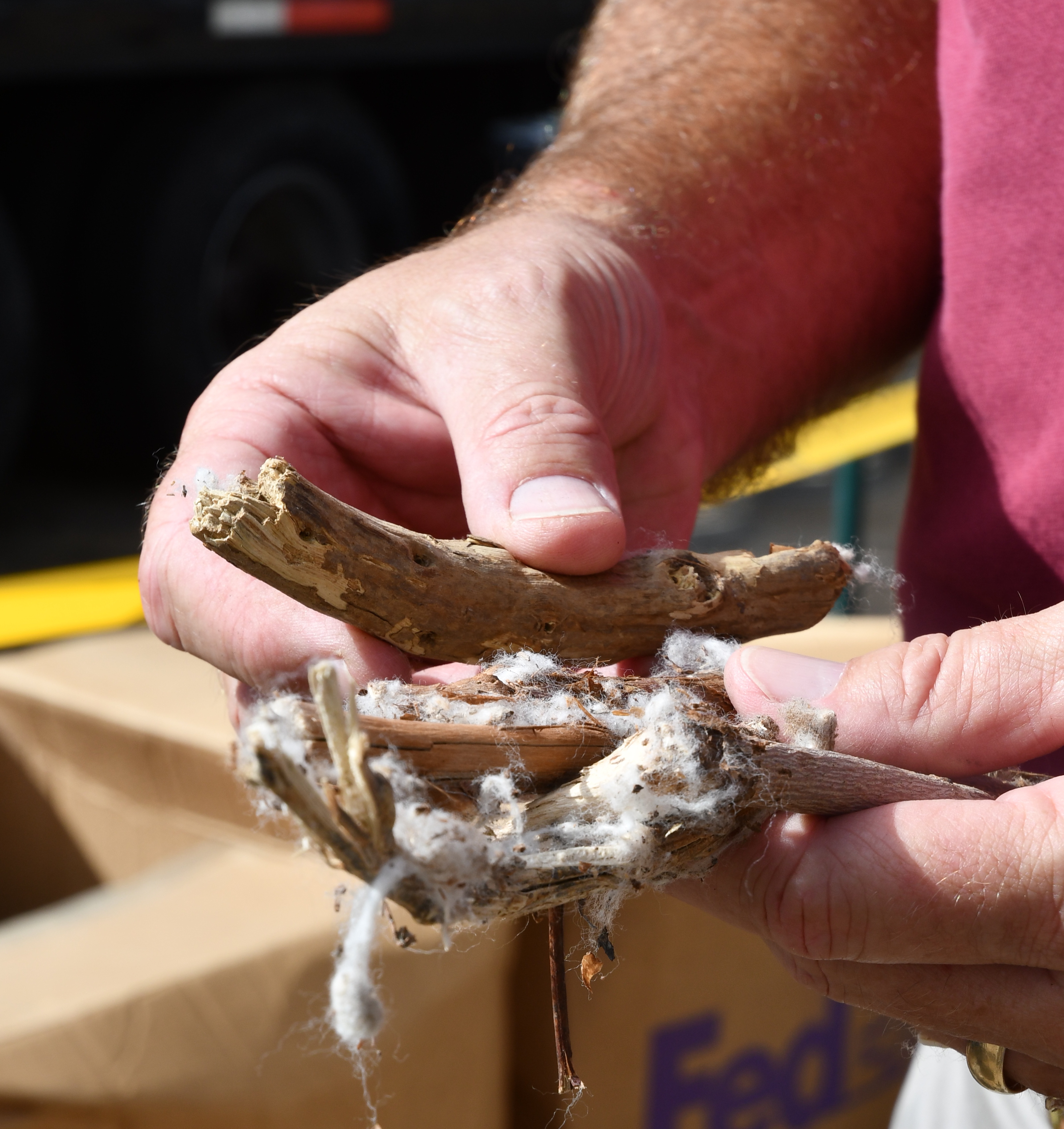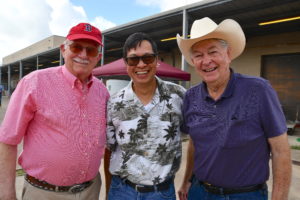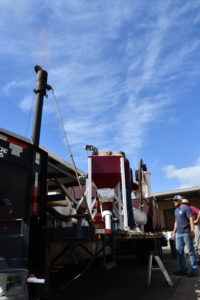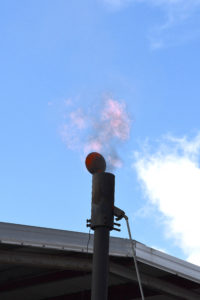Farm & Ranch
[AgriLife Today] Cotton gin trash finding new life for electrical power

By: Blair Fannin
Writer: Blair Fannin, 979-845-2259, [email protected]
Contact: Dr. Sergio Capareda, 979-458-3028, [email protected]
COLLEGE STATION – Finding sustainable markets for gin trash, wood chips and other waste products could be viable in producing more electrical power for a growing global population, according to researchers.
A demonstration was held recently on the campus of Texas A&M University in College Station showcasing a biomass-fueled fluidized bed gasifier, utilizing cotton gin trash and wood chips to power an electric generator. The fluidized bed gasification system was developed in the 1980s when a patent was issued to Drs. Calvin Parnell Jr. and W.A. Lepori, who were both part of the Texas Agricultural Experiment Station now Texas A&M AgriLife Research.
The fluidized bed gasification system was developed in the 1980s when a patent was issued to (left) Drs. Calvin B. Parnell, Jr. and (far right) W.A. Lepori, part of the Texas Agricultural Experiment Station (now Texas A&M AgriLife Research). Cotton gin trash and other biomass feedstocks have been used as fuel to generate heat energy for power production. The technology has been a focal point for (center)Dr. Sergio Capareda, a Texas A&M AgriLife Research agricultural engineer in the department of biological and agricultural engineering at Texas A&M, who researched the technology while working on his graduate degree during the late 1980s. Parnell and LePori were Capareda’s graduate advisors. (Texas A&M AgriLife Research photo by Blair Fannin)
Cotton gin trash and other biomass feedstocks have been used as fuel to generate heat energy for power production. The technology has been a focal point for Dr. Sergio Capareda, AgriLife Research agricultural engineer in the department of biological and agricultural engineering at Texas A&M, who researched the technology while working on his graduate degree during the late 1980s. Parnell and LePori were Capareda’s graduate advisors.
Cotton gin trash is produced in abundance at cotton gins across Texas and usually left unutilized, Capareda said. During harvest season, piles of cotton gin trash can be found at gins throughout the state.
“The process is gasification,” Capareda said. “We limit the amount of air to thermally convert the biomass so the products are combustible gases. These are collectively called synthesis gas. Carbon monoxide and hydrogen, plus a little methane, ethlyene, these are a combustible mixture. Combustible in a sense that you can feed it into an internal combustible engine coupled with a generator so you can turn this fuel into electrical power.”
“It’s easier said than done, because you have to remove the biochar and all the tar in the syngas before it goes into the engine. We have cleaned up the gas very well in this technology.”
The technology converts biomass into electrical power, making it an attractive opportunity for the ag, processing industry and electric utilities.
“For this particular demonstration, we used the conversion of cotton gin trash into electrical power,” Capareda said. “We also used wood waste and turned it into electrical power. With the price of electrical power at 10 cents per kilowatt-hour, the economics are very simple. If you run a 1 megawatt system and sell power for 10 cents per kilowatt an hour, your gross revenue is $1 million. If you find some countries overseas where power is very high, this technology is very attractive.”
A demonstration was held recently on the campus of Texas A&M University in College Station showcasing a biomass fueled fluidized bed gasifier, utilizing cotton gin trash and wood chips to power an electric generator. (Texas A&M AgriLife Research photo by Blair Fannin)
Cotton gin trash and other biomass feedstocks have been used as fuel to generate heat energy for power production. The technology has been a focal point for Dr. Sergio Capareda, a Texas A&M AgriLife Research agricultural engineer in the department of biological and agricultural engineering at Texas A&M, who researched the technology while working on his graduate degree during the late 1980s. (Texas A&M AgriLife Research photo by Blair Fannin) Capareda said the biomass used in the system has to be consistent, meaning whether you are using cotton gin trash or wood chips, it has to be relatively dry and clean without soil, rocks or metals.
“That’s how you begin, make sure it is dry and consistent,” he said. “Then you can run this system 24/7. We need 1.5-2 tons per hour or about 36 tons a day to generate 1 megawatt depending on the type of biomass. High-energy content biomass would need a little less than that. It also depends on heating value and moisture content of biomass.”
Bob Avant, director of corporate relations for AgriLife Research, said
“(This technology) has taken a very evolutionary approach going from a very basic system to one that is computerized. We’re very excited about it and think it has some good applications. We have a number of very big companies interested in this intellectual property.”
Farm & Ranch
Hazards of Backyard Poultry

By Barry Whitworth, DVM
Having backyard poultry is a popular agriculture enterprise. According to the United States Department of Agriculture, 0.8 percent of all households in the United States have chickens. People keep chickens for a variety of reasons with table eggs being one of the more common reasons.
Unfortunately, some of these poultry producers are not aware of the hazards that come with keeping poultry because many times they carry pathogens but appear healthy.
Chickens are carriers of several zoonotic diseases. These are diseases that can be passed from animals to humans. According to a recent survey in Pennsylvania, a majority of backyard poultry producers were aware of the dangers of avian influenza. However, this study also revealed that far fewer producers were aware of the risk of possible exposure to Salmonella and Campylobacter.
The lack of knowledge about the hazards of raising poultry likely contributes to the continued issues of Salmonella outbreaks associated with backyard poultry. In 2023, the Centers for Disease Control and Prevention reported 1,072 illnesses of Salmonella linked to backyard poultry, and 272 of those patients required hospitalization. Oklahoma reported 43 individuals with the disease.
To read more, pick up a copy of the April issue of NTFR magazine. To subscribe by mail, call 940-872-5922.
Farm & Ranch
Ag Elsewhere: Wyoming

By Tressa Lawrence
Babies are tucked away in every nook and cranny. Many ranchers across Wyoming have baby animals popping up all over this time of year.
Farm & Ranch
Ag Elsewhere: Montana

By Lindsey Monk
Another load of grain in to keep feeding the calves until the green grass can really start popping.
-

 Country Lifestyles1 year ago
Country Lifestyles1 year agoScott & Stacey Schumacher: A Growth Mindset
-

 Equine7 months ago
Equine7 months agoThe Will to Win
-

 Country Lifestyles7 years ago
Country Lifestyles7 years agoStyle Your Profile – What your style cowboy hat says about you and new trends in 2017
-

 Country Lifestyles4 years ago
Country Lifestyles4 years agoAmber Crawford, Breakaway Roper
-

 HOME7 years ago
HOME7 years agoGrazing North Texas – Wilman Lovegrass
-

 Country Lifestyles7 years ago
Country Lifestyles7 years agoDecember 2016 Profile, Rusty Riddle – The Riddle Way
-

 Country Lifestyles8 years ago
Country Lifestyles8 years agoJune 2016 Profile – The man behind the mic: Bob Tallman
-

 Outdoor9 years ago
Outdoor9 years agoButtercup or Primrose?









